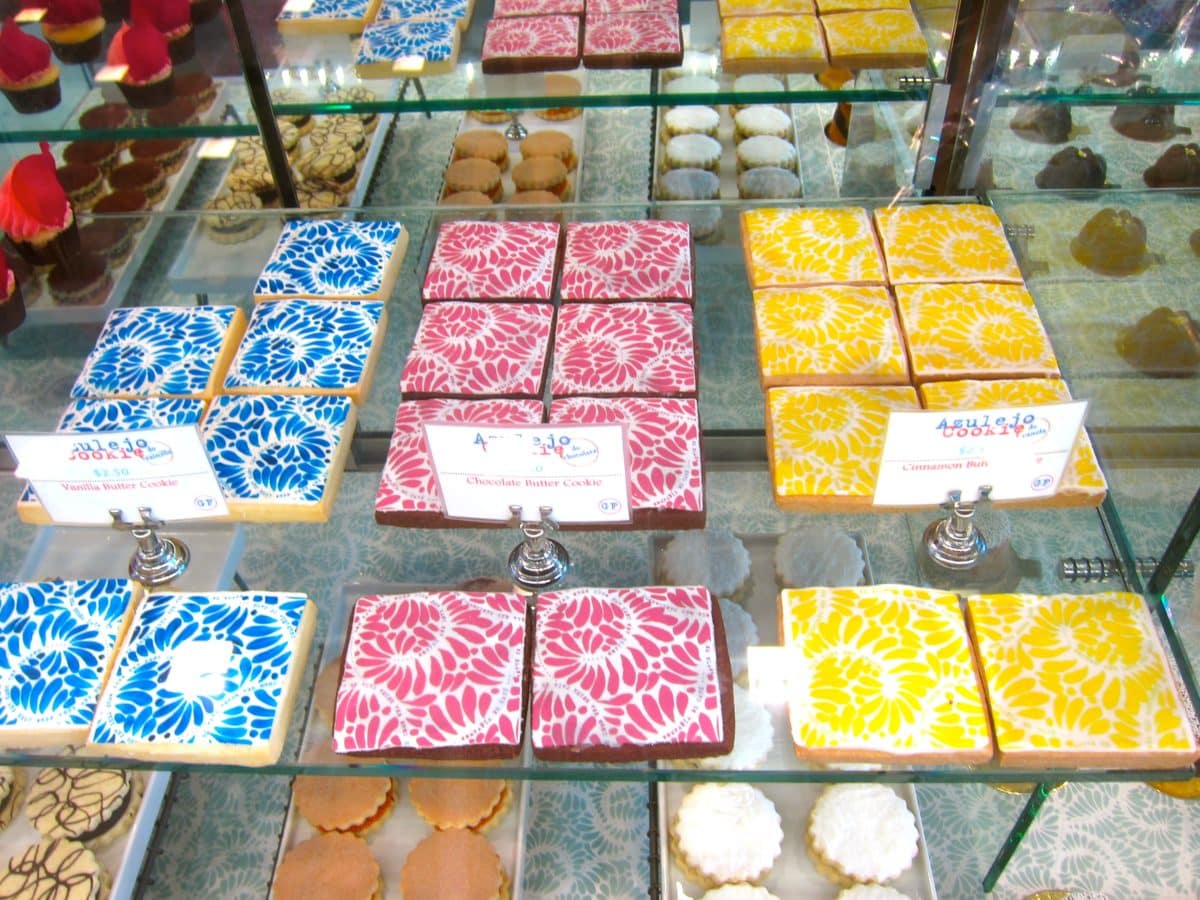Colorful Mexican tiles usually decorate walls, floors and building facades. But you can eat them too, and without cracking a tooth, if they are Mexican tile cookies from Compañía de Café in San Fernando, California.
The cookies look as if they’d been hand-painted, but that’s not possible when the bakers have to produce them rapidly along with a raft of other Mexican-themed pastries. The secret is a bit of technical wizardry that involves an ordinary computer printer, like the one you might have at home.
It’s more complicated than a simple print job, however, and so is best left to pros such as Tamara Davis, Compañía de Café’s executive pastry chef. This doesn’t rule out serious home artisans willing to buy the equipment and master the skills involved. But don’t think about whipping out cookies like these for a bake sale or birthday party tomorrow.
The tile cookies are a natural for the café, given its location. San Fernando is a sunny, quiet city, named for nearby Mission San Fernando Rey de España, which was founded in 1797. This Spanish/Mexican heritage permeates a soaring space decorated so charmingly with tiles and Mexican artifacts that the café would fit perfectly into the historic center of Mexico City.
Called azulejos (the Spanish word for tiles), the cookies are imprinted with a design that was inspired by the talavera ceramics of Puebla, Mexico. These ceramics were in turn influenced by Chinese porcelains brought to New Spain by the Manila galleons, enormous ships that sailed from Manila to Acapulco loaded with Chinese goods. Although the cargoes were sent across Mexico for shipment to Spain, much remained behind to influence local culture. That trade lasted from 1565 to 1815.
At first, blue and white were the fashionable colors, copied from the Chinese. Later, more colors were introduced until today talavera designs in Mexico can be downright gaudy. Compañía de Café’s tile cookies come in the traditional blue and white and also in yellow and pink on white. Each has a different flavor—vanilla for the blue and white cookies, cinnamon for the yellow cookies and chocolate for the pink cookies.
The tile design was worked out with the assistance of UCLA students specializing in art and Mexican culture. They did the brush work so that the tiles would appear authentically hand-painted. Swirling through the talavera pattern is the German proverb, “Coffee and love are best when they are hot.” This is not inappropriate considering that in the 19th century, German immigrants were welcomed into Mexico.

The cookies themselves are special too. They are gluten- free, made according to a proprietary formula worked out by Davis. “We wanted to create a cookie that someone with an allergy can enjoy and that someone who doesn’t have an allergy wouldn’t know is gluten-free,” she says. Gluten-free doesn’t mean they aren’t rich with eggs and butter, though.
After the dough is mixed, it is refrigerated overnight. The next day it is rolled out and cut into squares. These, too, are refrigerated overnight. The following day, the cookies are baked in a convection oven at 163° C/325° F, which would be 177° C/350° F in a home oven. Walk around to one side of the spacious area that houses the sales counter, coffee bar and tables and you can watch the pastry team at work through a window into the kitchen.
Unknown content block type: FlexiblePageTemplateFlexibleContentPhotoGalleryLayout
{
"__typename": "FlexiblePageTemplateFlexibleContentPhotoGalleryLayout"
}The same talavera design used for the cookies also decorates coffee cups and plates that are made for the cafe in Mexico. Thus your blue and white azulejo cookie is served on a plate printed with the same pattern. While you nibble on the cookie, you can drink one of the café’s specialty coffees from a matching cup, perhaps the mocha Diablo flavored with chocolate ganache and Mexican dried chiles, or a goat milk cajeta latte, flavored with Mexican caramel and chocolate ganache. The cups and saucers—they’re lead free—are for sale, and so are the azulejo cookies, which are displayed in the counter along with other tempting treats created for the café.
Compañía de Café opened in the spring of 2014. The location may seem out of the way, but thanks to freeways, it is easily reached from the center of Los Angeles, making it possible to drop in for a pleasant mid-morning coffee and cookie break even if you don’t live in the neighborhood.
Compañía de Café is located at 110 N. Maclay Ave., San Fernando, California 91340. The telephone is (747) 500-7102. Hours are Monday through Sunday from 6 a.m. to 11 p.m.
The San Fernando Compañía is the flagship café, where the recipes were developed and the brand established. A second, smaller Compañía de Café opened in November in South Gate, closer to downtown Los Angeles. The address there is 4705 Firestone Blvd. The phone is (323) 476-7201.

Where To Start
Commercial bakers and those willing to invest in printers to create edible photos can find a full range of professional equipment and supplies at Walkers Cake Decorating Supply. Products include printers, airbrush supplies, edible paper and inks, as well as other cake decorating supplies.
Home cooks who are intrigued by edible papers can find a large selection of very charming pre-printed papers at Fancy Flours. Their collection of edible wafer paper suitable for cookies includes old-fashioned designs, children’s themes, and holiday and celebration papers. The papers, which are made from potato starch, are applied to cookies very easily and need no special equipment. Cookies should first be frosted with royal icing and allowed to dry. A thin layer of corn syrup is then brushed on to serve as “glue,” and the decorative paper gently pressed on and smoothed.
While there are currently no designs like Mexican tiles, the available images — which include Chinese- themed papers, vintage handkerchief patterns, and sets of the nautical flag alphabet and periodic table of elements – are sure to inspire inspiration and delight. ![]()
